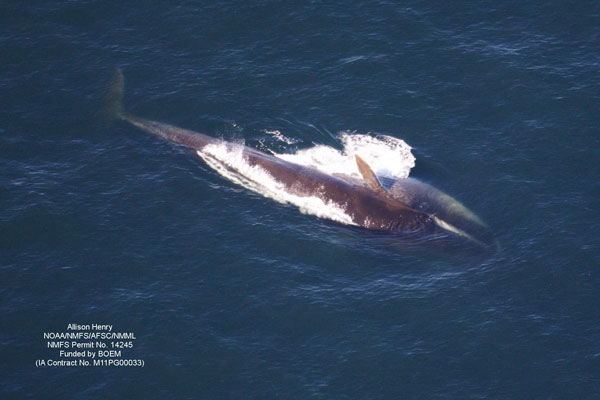
On September 11th of this year, low clouds covered the sky around Barrow. The whale observing team stationed there couldn’t fly their preferred route over active oil leases nearby. But the weather was better in the Southern Chukchi Sea, near Point Hope, so they decided to go there instead. Research Biologist Janet Clarke, a contractor with the National Oceanic and Atmospheric Administration, was managing the team:
“At the beginning of the day when our team was getting ready to do those surveys, in the back of my mind I’m thinking, ‘wow, I sure hope they find some gray whales down there,’ because that’s what we’ve seen in that area before.”
The team didn’t find any gray whales. Clarke was shocked. But then they started listing what they had seen:
“On that one flight we saw fin whales, 24 humpback whales, 5 killer whales and one minke whale. Reporter: So did your jaw kind of drop when you heard that? Clarke: yes, I would say that it did.”
Killer whales have never been seen before in the previous three decades of the survey. Fin whales and humpback whales have been documented just once. Minke whales, only a handful of times.
“Just the number and the diversity of species that were seen- it was just one after another after another.”
The Aerial Surveys of Arctic Marine Mammals project runs from July through October, with teams based in Deadhorse and Barrow. September 11th was a standout day for the survey. But the teams documented subarctic species on a handful of other flights as well. Megan Ferguson is a marine ecologist with NOAA and is Project Coordinator for the survey. She says it’s notable that several of the subarctic species were seen feeding in the Chukchi sea:
“That means that they’re using the resource. They’re getting nutrition from the environment in that area.”
And Ferguson says it was also surprising to see some calves. It’s more evidence that the arctic waters are being used as habitat:
“It means it is not just the adults, who are more burly in coming up there. They’re taking their kids up there. So it leads me to think there’s a reason they’re coming further north.”
All of the subarctic species were seen in the Chukchi Sea. Janet Clarke says it’s difficult to speculate why so many different whale species are spending more time in that area. But she says the massive arctic ice retreat is likely playing a role. It is transforming the ocean. And she says it has scientists talking about a “new normal” for the arctic.
“One thing that is just stunning is how different every year is. Things that we used to be able to predict and go, of course it’s going to be that-it’s not that any more. So it is really kind of this new normal that’s going on in the arctic in general.”
The annual whale survey is funded by the Bureau of Ocean Energy Management. And the survey encompasses the area the federal government has already leased to oil companies or is planning to offer for drilling in future years. Clarke says they did see Shell’s drill rigs this summer and some whales nearby. She says the annual aerial survey isn’t a good way to observe immediate impacts to whales from oil drilling. But the survey will be one tool to help assess the overall affects of drilling on marine mammals.
Annie Feidt is the broadcast managing editor at Alaska Public Media. Reach her at afeidt@alaskapublic.org. Read more about Annie here.





